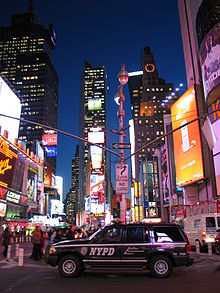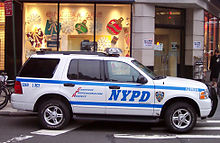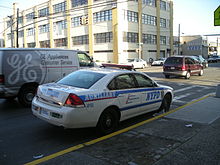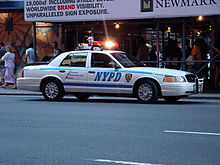- Crime in New York City
-
New York City Crime rates (2008) Crime type Rate* Homicide: 6.3 Forcible rape: 10.7 Robbery: 265.9 Aggravated assault: 297.6 Violent crime: 580.3 Burglary: 238.1 Larceny-theft: 1,410.2 Motor vehicle theft: 149.1 Arson: N/A Property crime: 1,797.3 Notes
* Number of reported crimes per 100,000 population.
New York City did not report arson statisticsSource: FBI 2008 UCR data Violent crime in New York City has decreased in the last fifteen years, and the murder rate in 2007 was at its lowest since at least 1963 when reliable statistics were first kept.[1][2] Crime rates spiked in the 1980s and early 1990s as the crack epidemic hit the city. During the 1990s the New York City Police Department (NYPD) adopted CompStat, broken windows policing and other strategies in a major effort to reduce crime. The city's dramatic drop in crime has been attributed by criminologists to these policing tactics, the end of the crack epidemic and demographic changes.[3][4] Most of the crime remaining occurs in poor areas, which tend to be outlying.
Organized crime has long been associated with New York City, beginning with the Forty Thieves and the Roach Guards in the Five Points in the 1820s. The 20th century saw a rise in the Mafia dominated by the Five Families. Gangs including the Black Spades and Supreme Team also grew in the late 20th century.[5] Numerous major riots have occurred in New York City since the mid 19th century, including the Draft Riots in 1863, the Stonewall riots, multiple riots at Tompkins Square Park, and in Harlem.[6] The serial killings by the "Son of Sam", which began on July 29, 1976, terrorized the city for the next year.[7]
Contents
19th century
Organized crime has long been associated with New York City, beginning with the Forty Thieves and the Roach Guards in the Five Points in the 1820s.
In 1835, the New York Herald was established by James Gordon Bennett, Sr., who helped revolutionize journalism by covering stories that appeal to the masses including crime reporting. When Helen Jewett was murdered on April 10, 1836, Bennett did innovative on-the-scene investigation and reporting and helped bring the story to national attention.[5] The murder of Mary Rogers in 1841 was also heavily covered by the press, which also put the spotlight on the ineptitude and corruption in the city's watchmen system of law enforcement.[5] At the time, New York City's population of 320,000 was served by an archaic force, consisting of one night watch, one hundred city marshals, thirty-one constables, fifty-one police officers.[8]
Peter Cooper, at request of the Common Council, drew up a proposal to create a police force of 1,200 officers. The state legislature approved the proposal which authorized creation of a police force on May 7, 1844, along with abolition of the nightwatch system.[8] Under Mayor William Havemeyer, the police force was reorganized and officially established on May 13, 1845 as the New York City Police Department (NYPD), with the city divided into three districts, with courts, magistrates, and clerks, and station houses set up.[8]
Riots and Massacres
In July 1863, the New York State Militias were absent to aid Union troops, when the 1863 Draft Riots broke out, leaving the police to crush the riots.[9] In 1870, the Orange Riots were incited by British Protestants celebrating the Battle of the Boyne with parades through predominantly Irish neighborhoods. 63 citizens, mostly Irish, were massacred in the resulting police-action.[6] The Tompkins Square Riot occurred on January 13, 1874 when police violently suppressed a demonstration involving thousands of people in Tompkins Square Park.[10]
20th century
Organized crime
In the 20th century, notorious New York-based mobsters Arnold Rothstein, Meyer Lansky, and Lucky Luciano made headlines. The century's later decades are more famous for Mafia prosecutions (and prosecutors like Rudolph Giuliani) than for the influence of the Five Families. Violent gangs such as the Black Spades and the Westies influenced crime in the 1970s. The Bloods and Crips gangs of Los Angeles arrived in the city in the 1980s, but gained notoriety when they appeared on Rikers Island in 1993 to fight off the already established Latin Kings gang. In 1980, a famous musician (John Lennon) was shot, which spiked New York's crimes.
Recent years
 An NYPD vehicle stationed in Times Square.
An NYPD vehicle stationed in Times Square. A NYPD Auxiliary RMP.
A NYPD Auxiliary RMP.
 NYPD Ford Explorer SUV
NYPD Ford Explorer SUV
Crime in New York City was high in the 1980s during the Mayor Edward I. Koch years, as the crack epidemic hit New York City, and peaked in 1990,[2] the first year of Mayor David Dinkins' administration (1990–1994). During the administration of Mayor Rudolph Giuliani (1994–2002), there was a precipitous drop in crime in his first term, continuing at a slower rate in both his second term and under Mayor Michael Bloomberg (2002–present). Many commentators have suggested that the New York City Police Department's adoption of CompStat, broken windows policing, and other strategies during the administration of Rudolph Giuliani were responsible for the drop in crime, some studies argued that the dramatic reduction in crime was strongly correlated with the increases in the number of police officers that started under Mayor Dinkins and continued through the Giuliani administration.
Freakonomics authors Steven Levitt and Steven Dubner attribute the drop in crime to the legalization of abortion in the 1970s, as they suggest that many would-be neglected children and criminals were never born. On the other hand, Malcolm Gladwell in his book The Tipping Point argues that crime was an epidemic and a small reduction by the police was enough to tip the balance.
Starting in 2005, New York City achieved the lowest crime rate among the ten largest cities in the United States.[11] Since 1991, the city has seen a continuous fifteen-year trend of decreasing crime. Neighborhoods that were once considered dangerous are now much safer. Violent crime in the city has dropped by three quarters in the twelve years ending in 2005 with the murder rate at its lowest then level since 1963 with only 539 murders that year, for a murder rate of 6.58 per 100,000 people, compared to 2,245 murders in 1990. In 2009, the low would be displaced. Among the 182 U.S. cities with populations of more than 100,000, New York City ranked 136th in overall crime.[12]
In 2006, as part of Mayor Michael Bloomberg's gun control efforts, the city approved new legislation regulating handgun possession and sales. The new laws established a gun offender registry, required city gun dealers to inspect their inventories and file reports to the police twice a year, and limited individual handgun purchases to once every 90 days. The regulations also banned the use and sale of kits used to paint guns in bright or fluorescent colors, on the grounds that such kits could be used to disguise real guns as toys.
In July 2007, the city planned to install an extensive web of cameras and roadblocks designed to detect, track and deter terrorists called Lower Manhattan Security Initiative, which is similar to the City of London's "ring of steel".[13]
As of December 31, 2007 New York City had 494 reported homicides, down from 596 homicides in 2006. This marked the first year since in 1963 (when crime statistics were starting to be published) that this total was fewer than 500.[14]
In 2008, there were 523 reported murders, a 5.2% rise from the previous year.[15][16]
While crime rates have stopped decreasing for a decade in the rest of the United States, in New York the murder rate for 2009 is at an all time low of 466, more than a 10% decline from the previous year, and the lowest count during the period that crime statistics have been recorded.[17]
In 2010 the New York Post reported that NYPD supervisors were under increased pressure to "fudge" crime stats by downgrading major crimes to minor offenses. However, the same researchers that provided the evidence "acknowledged that major crimes were at a historic low."
See also
- Timeline of New York City crimes and disasters
- United States cities by crime rate
- Crime mapping
- Crime in New York
References
- ^ Lueck, Thomas J. (December 31, 2007). "Low Murder Rate Brings New York Back to ’63". New York Times. http://www.nytimes.com/2007/12/31/nyregion/31murder.html?bl=&ei=5087&en=fa043bdde2c94504&ex=1199250000&pagewanted=print.
- ^ a b Langan; Matthew R. Durose (2003 December 3–5). "The Remarkable Drop in Crime in New York City". 2003 International Conference on Crime. Rome, Italy. http://www.scribd.com/doc/322928/Langan-rel. Retrieved 2009-04-17.
- ^ Johnson, Bruce D.; Golub, Andrew; Eloise Dunlap (2006). "The Rise and Decline of Hard Drugs, Drug Markets, and Violence in Inner-City New York". In Blumstein, Alfred; Wallman, Joel. The Crime Drop in America. Cambridge University Press. ISBN 0521862795.
- ^ Karmen, Andrew (2000). New York Murder Mystery: The True Story Behind the Crime Crash of the 1990s. NYU Press. ISBN 0814747175.
- ^ a b c Lardner, James; Reppetto, Thomas (2000). NYPD: A City and Its Police. Owl Books.
- ^ a b Johnson, Marilynn S. (2003). Street Justice: A History of Police Violence in New York City. Beacon Press.
- ^ "Son of Sam, David Berkowitz, famous serial killer". Crime Library / Court TV. http://www.crimelibrary.com/serial_killers/notorious/berkowitz/12.html. Retrieved 2007-06-06.
- ^ a b c Lankevich, George L. (1998). American Metropolis: A History of New York City. NYU Press. pp. 84–85. ISBN 0814751865.
- ^ Schouler, James (1899). History of the United States of America, Under the Constitution. Dodd, Mead & Company. p. 418.
- ^ Gordon, Michael Allen (1993). The Orange Riots: Irish Political Violence in New York City, 1870-1871. Cornell University Press. p. 203.
- ^ Zeranski, Todd (2006-06-12). "NYC Is Safest City as Crime Rises in U.S., FBI Say". Bloomberg News. http://www.bloomberg.com/apps/news?pid=10000103&sid=aHWGwSJjpbOU&refer=us. Retrieved 2006-10-30.
- ^ Zeranski, Todd. "How Safe is New York City?".
- ^ "New York plans surveillance veil for downtown"
- ^ Hauser, Christine (January 1, 2008). "Fewer Killings in 2007, but Still Felt in City’s Streets". The New York Times. http://www.nytimes.com/2008/01/01/nyregion/01murder.html?_r=2&sq=murder&pagewanted=print. Retrieved June 21, 2009.
- ^ New York Police Department CompStat report for week ending June 14, 2009. Retrieved June 21, 2009
- ^ "http://tacomaconfidential.typepad.com/the_murder_book_2008/"
- ^ Parascandola, Rocco (January 5, 2010). "2009 homicides in New York City are fewest since 1963". Daily News. http://www.nydailynews.com/news/ny_crime/2010/01/06/2010-01-06_2009_homicides_fewest_since_63.html.
External links
- Precinct Crime Statistics page - NYPD
- Statewide Anti-Fugitive Teams
- New York Law Enforcement Agency Uniform Crime Reports 1980 to 2005
- New York City Police Dept Uniform Crime Reports 1980 to 2005
- Fewer Killings in 2007, but Still Felt in City’s Streets
New York City History · Neighborhoods · Architecture · Skyscrapers · Tourism · Attractions · Culture · Books · Arts · Parks · Cuisine · Dialect · People · Music · Sports · Media · Economy · Companies · Education · Schools · Government · Mayor · Central Park · Council · Fire · Police · Landmarks · Crime · Elections · Geography · Harbor · Gardens · Flag · Environment · Demographics · Enclaves · Transportation · Hospitals · Lists · Images · Portal Categories:
Categories:- Crime in New York City
- Law enforcement in New York City
Wikimedia Foundation. 2010.



